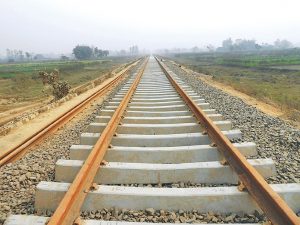NARROW GAUGE LINES NOT INFERIOR TO THE STANDARD GAUGE LINES- AMAECHI
The Minister of Transportation, Rt. Hon. Chibuike Amaechi has said that the narrow gauge rail lines are not inferior to the standard gauge lines.
Amaechi made the clarification amidst various reactions from some quarters, saying that the narrow gauge lines were inferior, sub-standard, and outdated in other parts of the world to the Standard gauge rail lines. He said that the only difference between the two lines was the speed.
He also said that the Eastern rail line was going to have both the Narrow Gauge and the Standard Gauge as it stands now but due to the cost of the standard gauge and what is feasible to embark on based on the time frame, it was cheaper to rehabilitate the Narrow Gauge which was about 3.2billion dollars which can be delivered within the approved time frame.
The Minister disclosed that the Standard Gauge lines were going to cost about $11 to 14billion dollars to construct, adding that getting the funds within the limited time was not feasible because of other projects awaiting funding.
“The Standard Gauge line is between $11 to 14billion dollars to construct on the Eastern flag, the standard gauge as designed in Nigeria is 150km design speed, operational speed is 120km, what is the difference between 120km and 100km? The Narrow Gauge is about 3.2billion dollars at 100km per hour.
” The Standard Gauge which is at $11 to 14billion dollars, is 120km per hour, so if you take off with the standard gauge let say to Damaturu, you will arrive 20minute before me that use the Narrow Gauge.
” The Narrow Gauge is cheaper, $3billion against the $11 to 14billion dollar to construct the standard gauge. Why we did not get the approval for the Narrow Gauge on time was because the President insisted on the standard gauge from Port Harcourt-Maiduguri, my argument was if I can achieve the same length of rail with 3billion dollars why not take that first until when we get money, we can now go for the standard gauge.
“Which made him approve the standard gauge as designed but until we get the money because if we continue to wait until we get the $11bn to 14billion dollars, we may not be able to construct the Eastern flag before we leave government.”

However, Engr.Fidet Okhria, Managing Director, Nigeria Railway Corporation (NRC) said that the Narrow gauge line was not outdated or less efficient stating that there should not be a comparison.
He said that Nigeria was the first African country to introduce a standard gauge line, stating that South Africa and other Africa countries still use the Narrow Gauge lines.
“In the whole of Africa, Nigeria is the only country that has introduced a Standard gauge line, South Africa, India, and other countries are still using the Narrow Guage line introduced by their colonial masters, other Africa countries are still using what the colonial master constructed.
“The Eastern rail line has both the standard and the Narrow Gauge lines to be constructed, the Narrow Gauge will be rehabilitated now because the fund is available but the reality of getting the $13billion now to construct the standard gauge line is not feasible.
“So, the Narrow Gauge is not inferior in any way, the difference is in the speed and it cannot carry more load like the Standard Gauge because the Standard Gauge is wider while the Narrow Guage is narrower which doesn’t make it less effective than the standard gauge.
“About the cost, there should be no comparison with the cost because one is $13billion while the other is about $3.2billion, $10billion difference.”
However, Engr. Muhammad Baba-kobi, Director Rail and Transport Services, Federal Ministry of Transportation said that the difference between the Narrow and the Standard Gauge rail lines is the width within the inner edge of the track which is called the Gauge.

He said that the Narrow Gauge in Nigeria is about 1067mm which is about 3ft, in some countries its 600mm which is 2ft while the standard gauge is 1437mm which is a little bit more than 4ft, noting that they are other Gauge like the Broad Gauge with 1670mm and the 2000mm Gauge with a wider distance.
Baba-Kobi, however, said that the use of any of the Gauge is by choice not necessarily the cost, noting that in places with hilly and curve terrain like the Port Harcourt-Maiduguri corridor, the Narrow Gauge would be best because its easy to negotiate curves and its lighter.
“The choice of one or the other relies on certain factors, either you put the standard or Narrow Gauge, you will still have an efficient and functional train, it just depends on your operational planning, it depends on where you want to take your train to.
“But technically, in most places where you have hilly roads that you have to negotiate into valleys, hills, and places with curves, the best in terms of Engineering for that terrain is the Narrow Gauge because it’s lighter, easy to navigate smaller curves and the engine can easily thrive.
“Talking on the speed, it depends on how the locomotives are powered, Narrow Gauge doesn’t mean it’s inferior, just a choice that you make purely from the kind of terrain you are passing through even some places Narrow Gauge is more expensive than the Standard Gauge,” he said.
According to him, looking at the terrain of the Eastern rail line because of the hills and curves, the Narrow Gauge is the best aside from the cost.
(FMoT Media)




